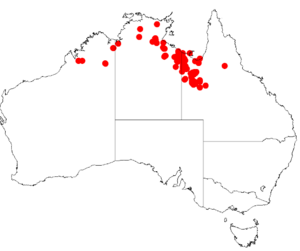Acacia asperulacea facts for kids
Quick facts for kids Acacia asperulacea |
|
|---|---|
| Scientific classification | |
| Genus: |
Acacia
|
| Species: |
asperulacea
|
 |
|
| Occurrence data from AVH | |
Acacia asperulacea is a type of shrub. It belongs to a large group of plants called Acacia, which are often known as wattles. This plant is a small, spreading shrub.
What Does Acacia asperulacea Look Like?
This small shrub usually grows to be about 0.2 to 1 metre (1 to 3 ft) tall. It blooms in May, showing off pretty yellow flowers.
The leaves of this plant are special. They are called phyllodes. These phyllodes grow in circles, with 10 to 14 of them in each circle. Each phyllode is a bit flat and can be straight or slightly curved. They are usually 5 to 14 millimetres (0.20 to 0.55 in) long.
Each flower head has 15 to 30 small flowers. Later, seed pods form. These pods are long and thin, without hairs, and have thick edges. Each pod is about 30 to 35 mm (1.18 to 1.38 in) long and 6 mm (0.24 in) wide. Inside, there are seeds that are about 3 mm (0.12 in) long and grow at an angle.
A. asperulacea plants usually live for 11 to 20 years. They can start making seeds after they are three years old.
How Was Acacia asperulacea Named?
The first official description of this plant was made by a botanist named Ferdinand von Mueller in 1859. He wrote about it in a scientific paper.
Over time, this plant has been known by a few other names. Some scientists, like George Bentham and Karel Domin, gave it slightly different names in the past.
Where Does Acacia asperulacea Grow?
This plant is native to a specific area in Australia. It grows in the eastern Kimberley region of Western Australia. It likes to grow in thin, rocky soils.
Its natural home also stretches east into the Northern Territory and reaches the far northwest part of Queensland.

